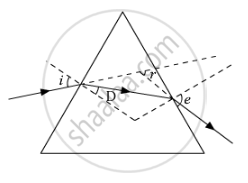Advertisements
Advertisements
प्रश्न
- A beam of monochromatic light undergoes minimum deviation through an equiangular prism, how does the beam pass through the prism, with respect to its base?
- If white light is used in the same way as in part (a) above, what change do you expect in the emergent beam?
- What conclusion do you draw about the nature of white light in part (b)?
उत्तर
- The beam of light pass parallel to the base.
- White light splits into its constituent colours i.e., spectrum is formed.
- White light is Polychromatic.
APPEARS IN
संबंधित प्रश्न
Describe an activity to show that colours of white light splitted by a glass prism can be recombined to get white light by another identical glass prism. Also draw ray diagram to show the recombination of the spectrum of white light.
After tracing the path of a ray of light through a glass prism a student marked the angle of incidence (∠i), angle of refraction (∠r) angle of emergence (∠e) and the angle of deviation (∠D) as shown in the diagram. The correctly marked angles are :

(A) ∠i and ∠r
(B) ∠i and ∠e
(C) ∠i, ∠e and ∠D
(D) ∠i, ∠r and ∠e
Draw a ray diagram to explain the term angle of deviation.
The property of splitting of white light into its seven constituent colours is known as
Out of air and glass, which is optically rarer? Give reason.
If a monochromatic beam of light undergoes minimum deviation through an equiangular prism, how does the beam pass through the prism, with respect to its base?
Make the correct choice for each of the following:
Which one of the following Fig correctly shows the path of the ray through the glass block?
The wavelengths of violet and red light are 4000 Å and 8000 Å respectively. Which of the two has the higher frequency?
State two uses of ultraviolet radiation.
Draw a neat and labelled diagram for dispersion of light.
